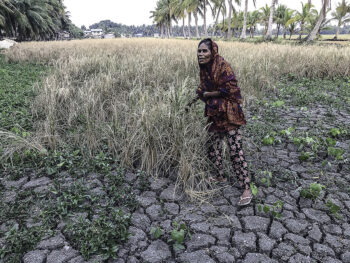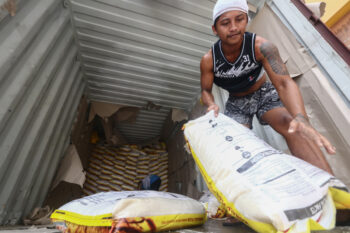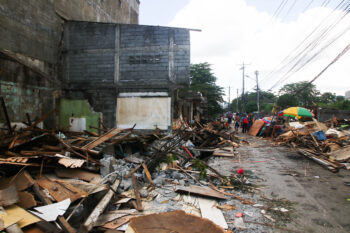
BOOK REVIEW: Through the Years, Gently
By Nikki Rivera Gomez
The University of the Philippines Press, 2019
Karl M. Gaspar CSsR
DAVAO CITY (MindaNews / 13 June) – In a few decades from now, if ever a historian will write the definitive book in the contemporary history of Mindanao – but not from an imagined set of facts that could only perpetuate fake myths but one based on solid research – she/he will need a book of the THROUGH THE YEARS, GENTLY type.
Nikki Rivera Gomez’ third book, as quoted in a blurb at the back page, is “a nonlinear excursion into the author’s mind and across his life experiences” – traversing the years from 2003 to 2017. While it was published in late 2019, the onset of the pandemic did not allow for a formal launching of this book, which is why it is part of the collective launch of all books published during the pandemic period at the start of the Second Mindanao Book Festival to be held on June 13, 2022.
For the historian, this book is a treasure trove of information about the region’s contemporary realities, providing the names, dates and places as events unfolded. Accuracy of data is guaranteed owing to the author’s excellent journalistic competence honed through the early years of militant reportage. At the same time, the author writes with a poetic flair which is why the essays are not just news stories or political opinions but at times read like excerpts of a novel. The book thus contributes to the rise of not just a nascent Mindanao journalism that was coming-of-age during the dark Marcos terror reign but also its literature.
An untoward consequence of this book’s publication is that it can provide the reader with a view of how the post-EDSA years – specifically covered by the author’s 2003-2017 timeframe – unfolded in Mindanao. One can actually go back to these years and trace the beginnings of what the millennial generation now take for granted.
For it was during this period when major changes were taking place in Mindanao’s various landscapes even as earth-shaking events were simultaneously occurring in various parts of the world. The author’s own major personal shift from his desk at a fledgling news bureau (operating as an NGO) to a position at the top of the bureaucracy not just provided him the lens through which he could view local events unfolding in the Duterte-run city of Davao but ultimately to cover national and international events.
Thus the book contains news stories, commentaries and his musings of the early years of the Duterte-initiated war on drugs in Davao City, the eruption of violent hostilities across Mindanao and the failed attempts at peace negotiations, the extent of corruption of the government bureaucracy and its various manifestations of being a weak State and the manner that the WB-IMF and US imperialism perpetuates the poverty situation of the poorest nations in the world, e.g., Haiti.
Through his writings, Gomez identifies the shifting fortunes of institutions and agencies and the rise of movements and technological advances that would have profound consequences for the country and the world. Through his attempts to relay to his readers his analysis of why things were unfolding, Gomez also hurled warnings to assuage their own doubts and fears. Although one can surmise that he was also addressing himself in the process!
On this book’s pages, it is so uncanny for those who were at the forefront of the protest movement of the ’60s-’80s to be reminded of their own “golden years” and realize that the 2003-2017 period was when:
- The NGO movement that arose with the mushrooming of legal institutions (LIs) two decades earlier was beginning to self-destruct and would now be just a shadow of what once was the most creative and pro-active sector across Davao and Mindanao;
- The peace-building efforts involving the Church’s inter-faith dialogue thrust that contributed to evolving a culture of peace faced tremendous odds amidst the high costs of the wars’ violence in terms of loss lives and property as massacres after massacres took place, as waves of bakwits were forced to flee the conflagrations;
- The country’s debt was ballooning at a rate that would continue to bedevil our economy, the impact of which will need to be shouldered by clueless generations still to be born in this Republic;
- The revolutionary movement, too, would suffer its own downfall as militancy among the youth is overtaken by a younger generation’s fascination with the new technological gadgets being peddled due to a boom of mall construction (how quaint at how the author notices the entry of a cell phone in his own life in 2003!);
- How the “Hizzoner” (the author’s pet name of President Duterte which just means “the man holding the office of the Mayor”) evolved into the strong man that he is labeled today from a small-town mayor whose war on drugs would eventually lead to the case now pending in The International Criminal Court investigating “crimes against humanity.”
- But of prime importance for those who are now in the forefront of Mindanao/Davao’s ecological movement is how this period gave rise to what is now the one advocacy that unites generations owing to concerns due to climate change and the need to push for climate justice. The book identifies who were at the forefront of the initial moves to bring to the citizenry’s attention the urgency of this environmental issue and how today’s realities are further worsening (e.g., the extent of calamities especially destructive typhoons and floods, the threat of open-pit mining and expansion of toxic-laden agri-business plantations, uncontrolled waste resulting in pollution of air and water, persistence of the usage of fossil fuels and the lack of initiatives to find renewable sources of energy).
This book would probably be of special interest to those of Gomez’ generation, namely the Gen-X (born between 1965-1980) also known as the martial law babies. Their generation bridge the baby boomers who constituted the bulk of the youth activists (mainly students although later also out-of-school youth) who began to march in the streets in the late 1960s and suffered the consequences of the brutalities of the Marcos terror reign in the 1980s). It was their generation that faced angst and tensions as they faced great difficulties in how to deal with the repercussions of EDSA I for both personal and political considerations (even as they were mouthing the slogan – “The personal is also political!”). And like Gomez himself had to make the necessary shifts, not always in consonance with their youthful idealism!
The book can actually be instructive for those who would try to explain the reasons behind these shifts. In a way – again as an untoward consequence – Gomez’ anthology becomes a case study for those interested to dig deeper into how mindsets and orientations would radically be transformed across generations. (It could help explain one perplexing question: why did some of the anti-martial law activists of the ’70s-’80s be part of the BBM-Sara voters in 2022?) By reading from the first entry in 2003 to the last one in 2017, the astute reader can actually plot the shifts in Gomez’ political purview. While some may shake their heads, others may nod in recognition of their own struggles in the political spectrum of opinions.
However, the book is not just about political matters, but it dwells also into the personal (but then again these are so intertwined!). Gomez does provide a respite especially in the writings under Part VIII – which is sub-titled “When dengue strikes and other intimate prose.” Here is where Gomez is at his poetic best when he “also offers a more intimate glimpse into his heart as he shares the tenderness of family, the empathy in conversations, and the catharsis of journalistic storytelling.”
The author is confronted with the sickness and death of his loved ones, the pains and struggles of fatherhood, the insecurities that come with mortality and of life’s impermanence. That our ephemeral existence can just so easily give way moments of deep pain and grief. And that it is always in remembering that we can find the antidote to an existential feeling of being left alone.
In A Brightened Room essay (on page 224), Gomez writes with a sense of pathos that can easily echo in any reader’s heart: “Perhaps it is true that we die a little as a loved one departs. But in the moments after we had knelt and wept and felt alone, it came to me how right I’d always been, that we seek solace from memories, we bask in the remembrance of laughter, and we die, and live again, in a cycle of mirth and sorrow, in knowing all this to be true.”
[MindaViews is the opinion section of MindaNews. Redemptorist Brother Karl Gaspar is a professor at St. Alphonsus Theological and Mission Institute (SATMI) in Davao City and until recently, a professor of Anthropology at the Ateneo de Davao University. Gaspar is author of several books, including “Manobo Dreams in Arakan: A People’s Struggle to Keep Their Homeland,” which won the National Book Award for social science category in 2012, “Desperately Seeking God’s Saving Action: Yolanda Survivors’ Hope Beyond Heartbreaking Lamentations,” two books on Davao history, and “Ordinary Lives, Lived Extraordinarily – Mindanawon Profiles” launched in February 2019. He writes two columns for MindaNews, one in English (A Sojourner’s Views) and the other in Binisaya (Panaw-Lantaw). Gaspar is a Datu Bago 2018 awardee, the highest honor the Davao City government bestows on its constituents.]







